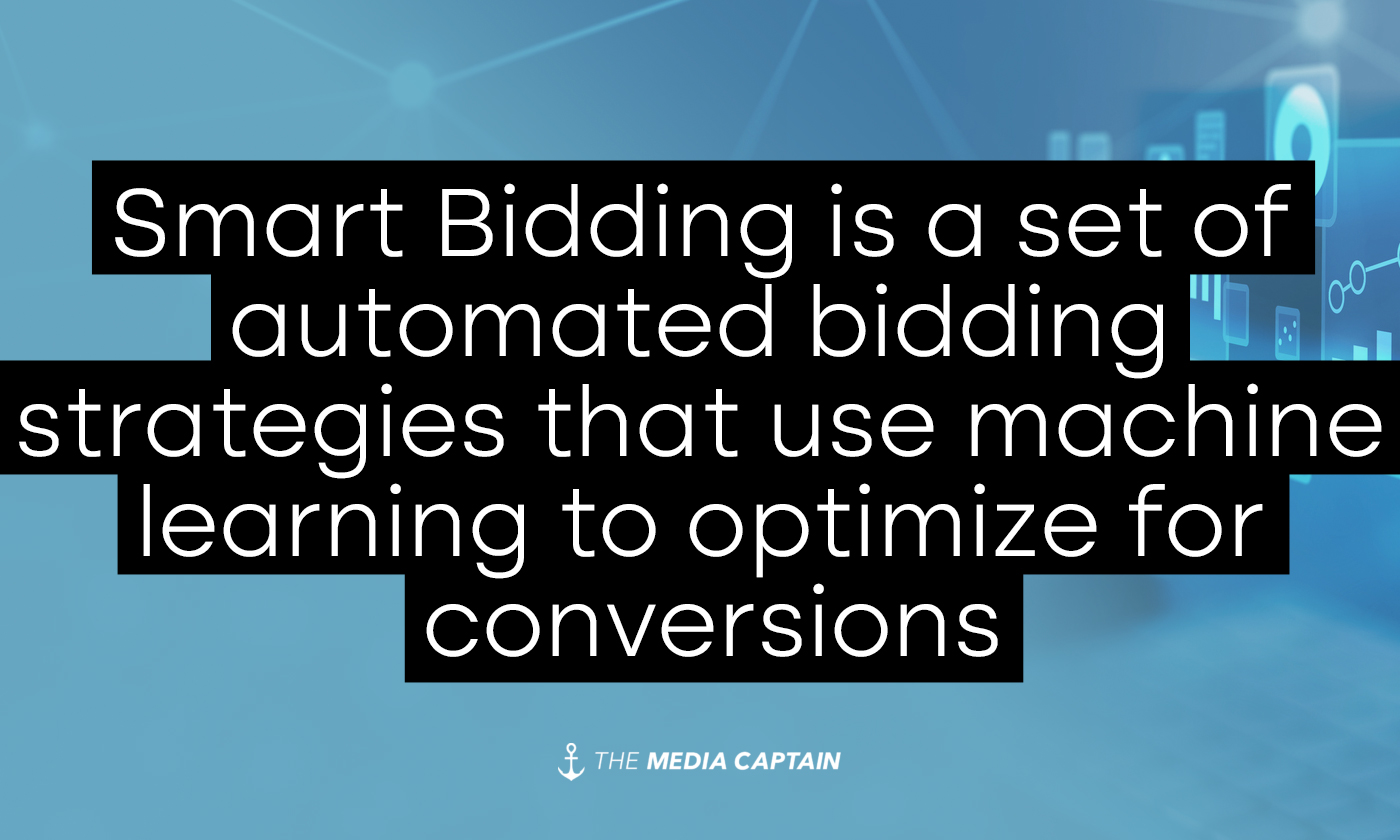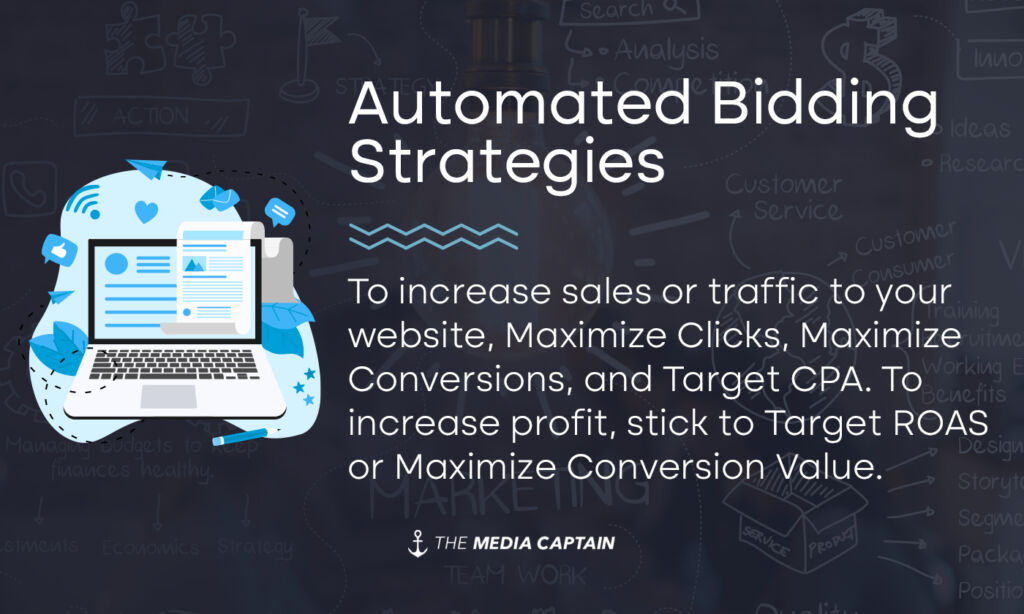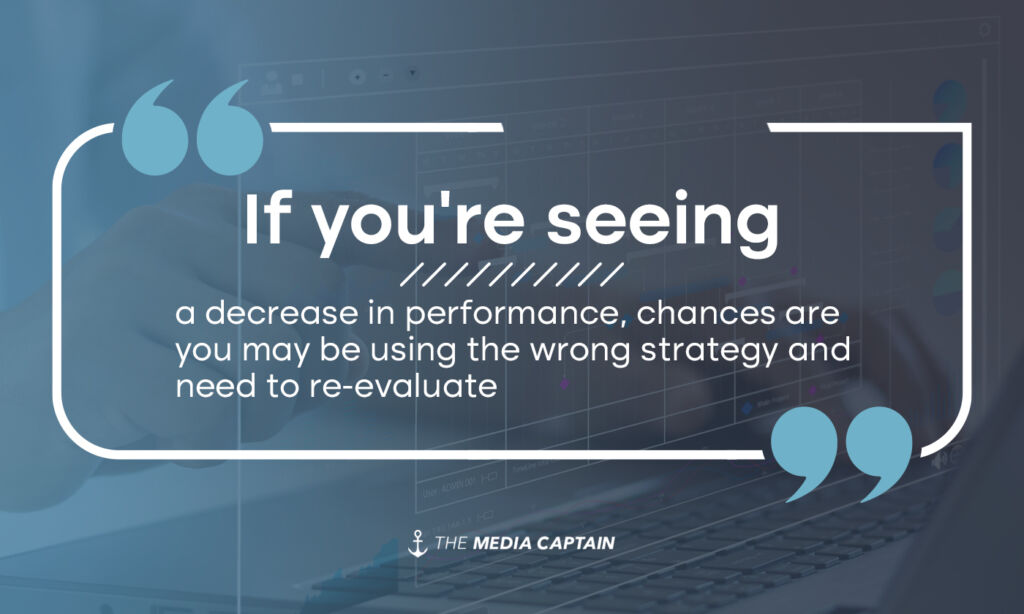Unlike manual bidding, which allows you to manually set a bid for each product within your Google ad campaigns, automated (or smart) bidding does just as the name suggests: it allows you to automate your campaigns and lets Google set bids depending on the campaign’s goals.
According to Google, “automated bidding takes the heavy lifting and guesswork out of setting bids to meet your performance goals. Unlike Manual CPC bidding, there’s no need to manually update bids for specific ad groups or keywords. Google Ads sets bids for your ads based on that ad’s likelihood to result in a click or conversion that helps you achieve a specific goal for your business.”
We’ve implemented automated bidding for many of our clients. While Google’s smart bidding doesn’t make sense for every client, we’ve seen great success with it for many.
Need help setting up your Google ad campaigns? Contact The Media Captain!
When Should You Use Manual Vs. Automated Bidding?
When to Use Manual Bidding
For Google’s automated bidding to work effectively, you need data within your campaigns so that Google’s algorithm can make informed decisions about your bids. Manual bidding makes sense when you’re just getting started out as this strategy can help you generate clicks and increase website traffic. Manual bidding can help you build up the initial data that you need to then utilize smart bidding strategies. The one exception to this is with the maximize clicks automated bidding strategy, as this can also help you increase traffic to your website and ensure you hit a target budget. This can also be used as you’re accumulating data, but won’t help you reach a target cost per conversion.
Note: If you want to add some automation to your manual bidding strategy, you can add enhanced cost per click. This will allow Google to automatically adjust your manual bids up and down to try to maximize conversions.
If you’re an eCommerce business and only have a few products within your Google shopping campaigns, manual bidding can also be a great strategy, as this will allow you to set specific bids on every product. If you have one $20 product and one $200 product, manual bidding may be an excellent choice since this will allow you to spend more on your bids for the more expensive product. With a small number of products, manual bidding is very manageable and can be advantageous, as it gives you more control and allows you to set the maximum cost per click (CPC) on each product.
When to Use Automated Bidding
Automated bidding takes the guesswork out of your ad campaigns. Not only that, this strategy makes them a whole lot easier to manage. If a client has a ton of products or search keywords, manual bidding is often not feasible, and automated bidding is the best strategy.
Google has several automated bidding strategies available (more on this below) and each one of them helps accomplish a specific goal. If you want to a customer to take a specific action on your website or focus on conversions or conversion value, then smart bidding is the way to go.
For our in-house eCommerce brand, DermWarehouse, we sell thousands of products and focus on conversions. For any eCommerce business, a conversion is going to be someone placing an order on the site. For a dentist client, we would also use an automated bidding strategy and focus on conversions as well, with the conversion being a phone call to the practice or someone booking an appointment via a booking link.
The Different Types of Automated Bidding Strategies
If you’re planning to use Google’s automated bidding strategies, you’ll have some choices to make. There are many different strategies to choose from. If you’re looking to increase sales or traffic to your website, Maximize Clicks, Maximize Conversions, and Target CPA are the best strategies to choose from. If you want to increase profit, stick to Target ROAS or Maximize Conversion Value.
Maximize Clicks
With the maximize clicks strategy, the main goal is to increase site visits. Google is aiming to get as many clicks to your campaigns as possible. This is a great strategy to use when you’re just starting and you want to start gathering search term data or drive a ton of traffic to your site. Ensure you’re keeping an eye on your budget and being diligent about setting negative keywords with this strategy. Driving a ton of traffic to your site is excellent, but you want to ensure you’re not wasting your budget on low-quality traffic. If you see that many search terms are irrelevant, this may not be the best bidding strategy for you.
When we get a new client and are building out their ad campaigns for the first time, we generally start with a maximize clicks strategy so we can get some data into their campaign before moving over to a different automated strategy.
Maximize Conversions & Target CPA
Once again, the name says it all here. With maximize conversions, Google will aim to get as many conversions for your campaigns as possible. This automated bidding strategy focuses on targeting those more likely to convert and is less focused on driving a lot of traffic to your site. Within the maximize conversions strategy, you’ll have the choice as to whether you want to target a cost per acquisition (CPA). If you want to spend your entire budget, you will want to leave this area blank. Google will work to spend your budget while also maximizing conversions. If you want to target cost per acquisition, you may not spend your entire budget, but Google will aim to get as many conversions as possible at the target CPA that you set. If your goal is to acquire new customers at a profitable level, target CPA will make sense for you. When you’re just looking to get new customers and aren’t as concerned with the cost per acquisition, you can use maximize conversions.
With DermWarehouse, while we know the profitable level of acquiring a customer, the profitability of our first order from Google is not as important to us. The reason for this is because we’re aiming to acquire all the new customers we can get. We know that 55% of our customers turn into repeat business. We know that once we get someone in the door, there’s a high likelihood that they’ll stick around and continue shopping with us. Because of this, the profitability of our first order isn’t as important since we keep our customers in our funnel for a long time.
If repeat business is unlikely for you, targeting a specific CPA can be more important because you need to acquire each customer at a profitable level, otherwise the cost of the ad spend won’t make sense for you.
Target ROAS & Maximize Conversion Value
Target ROAS (or target return on ad spend) is one of my favorite bidding strategies and is the one I use most often. With Target ROAS, you can choose a return on ad spend that you’re aiming to achieve and Google will work to hit that return. If you know that you need a 3 to 1 ROAS to be profitable, you can set your target return on ad spend to 300%. The issue we run into with this strategy is that if you set your target ROAS too high, you won’t hit your budget. We always start this slightly lower than we’re really aiming for and slowly work our way up as the campaign continues performing well. If you want to optimize for conversion value but also want to spend your entire budget, then utilizing the Maximize Conversion Value strategy may be the best bet for you.
Learn More: How to Optimize Google Shopping Ads for a Better ROAS
The goal of target impression share is to increase the visibility of your website. Google will aim to show your ads on the top of the page or at the top of the search results, depending on your selections. This bidding strategy is only available for Google search campaigns, not shopping, but I still wanted to mention it here.
What are the Benefits of Automated Bidding?
Saves Time
Likely, the biggest advantage of automated bidding within your Google Shopping campaigns is that it will save you much time. Having to go into every campaign and manually adjust bids is very time-consuming and sometimes not feasible. If you’re an eCommerce business have a lot of products that you’re selling, for example, making manual bid adjustments can be unmanageable and unrealistic. Google’s automated bidding strategies take the work off of your plate and automate the entire process. While there are still adjustments you’ll need to make within the campaign, such as adding negative keywords, the bulk of the work will be done for you.
Learn More: Save Money By Mastering Google Ads Search Terms Report
Use Google’s AI
There’s no denying how smart Google is. Why not take advantage of their AI and use it to your benefit? Based on their algorithms, Google will use your bidding strategy to predict how much to bid within your campaigns. Of course, Google wants you to spend your budget, which can sometimes come at the cost of campaign performance. Even though the bidding strategies are automated, you’ll still want to closely monitor their performance.
Customize Campaigns Based on Your Goals
Google’s smart bidding allows you to choose goals and targets and customize your campaigns based on these. You tell Google what your goals are for the campaign, and they will handle the rest to help you reach those goals.
Ensures Changes are Constantly Taking Place in Your Account
Chances are that managing your Google ad campaigns isn’t your only responsibility on a day-to-day basis. It’s easy to become inconsistent with logging in and making enhancements. With Google’s automated bidding strategies, you know that changes are constantly taking place within your account, and this is something you can take off your plate. This is the beauty of automation!
Can Help Improve Campaign Performance
When you’re consistently working to improve your campaigns, and Google is making regular enhancements based on new data coming in, the hope is that campaign performance will improve. Again, this relies on you making sure you’re regularly logging in to check performance and make your own adjustments, but using these automated bidding strategies should improve performance overall. If you’re seeing a decrease in performance, you may be using the wrong strategy and need to re-evaluate.
Learn More: What is a Good Return on Ad Spend for eCommerce?
In Closing:
- Automated bidding allows you to take the guesswork out of your Google ad campaign. They utilize Google’s AI to automate your campaigns based on goals and targets that you set.
- There are different smart bidding strategies to choose from. Make sure you understand the purpose of each strategy and pick the one that makes the most sense for each campaign, along with your business objectives.
- Google’s automated bidding has a lot of benefits, including saving time, taking advantage of Google’s AI, customizing your campaigns, ensuring changes are constantly taking place, and improving campaign performance.




